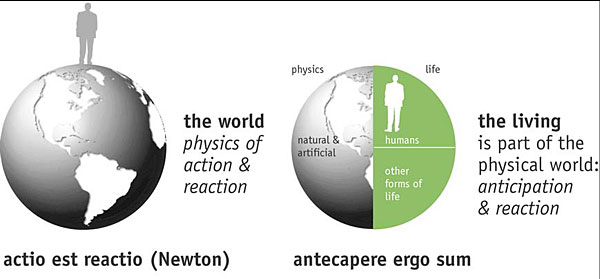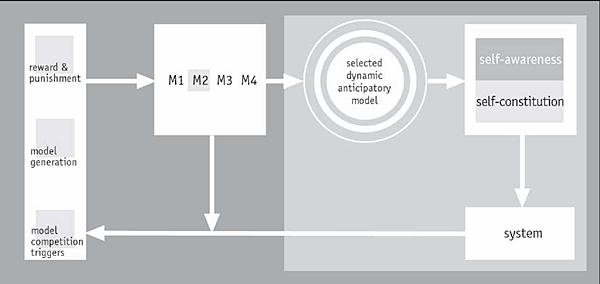Can Institutions Anticipate?
Diskussionsforum “Technikfolgenabschätzung”, Nr. 3 / 4, 12. Jahrgang – November 2003, S. 144-148 by Mihai Nadin, ANTÈ – Institute for the Research of Anticipatory Systems PDF The constructivist perspective and foundation in social systems theory is a very unusual framework for defining the modus operandi of a state agency [1] , in this case the […]
Diskussionsforum
“Technikfolgenabschätzung”, Nr. 3 / 4, 12. Jahrgang – November 2003, S. 144-148
by Mihai Nadin, ANTÈ – Institute for the Research of Anticipatory Systems
PDF
The constructivist perspective and foundation in social systems theory is a very unusual framework for defining the modus operandi of a state agency [1] , in this case the German Federal Ministry for Education and Research (henceforth the BMBF). The observer is part of the mechanism subject to his observations, which reminds me of a very good video dedicated to constructivism : Suspicious Minds. Die Ordnung des Chaos (Krieg 1991). The juxtaposition of statements made by von Foerster, Maturana, and Stierlin against tricks performed by a magician before a child watching in amazement was not accidental there, just as my reference to the video is not accidental here. Indeed, institutions acting in social-political environments as varied as those of Germany and of the USA must perform magic for the entity we call society (the social systems theory defines it as a communicational entity). It is expected that such institutions acknowledge innovation, distinguish the authentic from the fashionable, encourage competition, and support the worthy. These are tasks for which no ready-made solutions exist and no effective procedures are possible.
Otto Bode, not unlike others dedicated to understanding what it takes to cope with the new in science and technology grounds this understanding in a rational framework. He justifies its various manifestations within the rationality adopted. Bode writes a very convincing manual of operations for innovation and technology analysis (henceforth ITA, i.e., Innovations- und Technikanalyse ), which can as well be a manual for performing the magic of efficiently assessing innovation (Bode 2002). Fully aware of the unavoidable circularity of the enterprise he thoroughly identifies the perspective he adopts. That his ITA is of crucial importance – failure to realize the impact of innovation and technological progress can have extreme consequences, both bad and good – goes without saying. What remains to be seen is whether the adopted premise is ultimately more adequate to the ITA task than alternative options practiced in technologically oriented societies around the world. Let us not forget that every attempt to validate innovation is as good as our ability to define innovation in the first place. In other words, and in the spirit of the constructivist thought, it all depends upon the eyeglasses through which one examines what is submitted as innovation.
In the spirit of his premise, Otto Bode realizes that there is a progression from TA (technology assessment) and its associated institutional practice to ITA and the new means for ITA implementation he structures through the BMBF. The change of perspective, illustrated in a drawing that goes back to a constructivist visual icon – a spiral replaces circularity – is convincingly explained. The coherence of his model deserves a clear expression of respect.
But my concern is rather with adequacy than with coherence. In regard to adequacy, the epistemological level – social systems theory and constructivism – is as good as any other. The shortcoming derives from the description of reality adopted, not from the awareness that ultimately this description is as limiting as any other. I am consciously (and deliberately) leaving aside the terminology and operational schemes that political correctness imposes. Europe, not unlike the USA, will sooner or later realize the high price it pays for practicing demagoguery and encouraging mediocre uniformity at the expense of acknowledging difference as a source of innovation and progress [2] (see also Nadin 2001). The core issue is not political, but cognitive. Allow me to explain.
Scientific and technical innovation are an expression of human progress in understanding the world and the ability of humans to transform this understanding into improved and effective means of activity. The description at the basis of humankind’s spectacular scientific and technological advancement derives from the deterministic model that has shaped the western world for over 400 years. This statement stands independent of bureaucratic assessments, and very often against the predictions that such assessments have made. The reduction of all there is to the description of a machine [3] (see also Rosen 1985) – and in our days, programs or procedures can be such machines – results in an understanding of causality based on procedures for reducing complexity. Otto Bode takes the complexity of ITA and tries to reduce it through well-defined procedures anchored in the constructivist thought of social systems theory. This no doubt reflects progress in an area of social action driven by opportunism rather than by coherent evaluation procedures. But it also conceals the major weakness of the increasingly critical activity involved in ITA. Reductionism and determinism, no matter what their nature, are fundamentally reactive. A foundation of ITA based on a model in which the past determines the future can in final analysis be only incomplete.
If the description of the world in the body of knowledge we call physics (and subsequent derivations in chemistry, electronics, materials science, among others) is indeed the foundation of the spectacular progress in science and technology that we experience, this description captures only partially, in the best of cases, what the living is (cf. Fig. 1).

Figure 1: Concept for ANTÈ – Institute for Research in Anticipatory Systems
No doubt the living itself has its physicality ; but it also has an additional dimension expressed in its ability to anticipate. Information processes, and maybe some even more intricate processes, such as quantum entanglement (Bohr 1935), which might be a good metaphor for anticipation, provide insight into the dynamics of life, so different from the dynamics of the non-living. The non-deterministic aspects of the living are complementary to the deterministic characteristics: A cat will always fall, but in a different way each time, while a stone will fall the same way over and over again (cf. Nadin 2003a).
Given space limitations, I cannot expound here on anticipation beyond a rather summary description. What I can do is to point out that within the deterministic model we can succeed by adopting descriptions of outcomes or processes based on probabilities. Being after the fact, probabilities allow us to infer from what was to what might be within the same deterministic framework. Anticipation can be seen as a characteristic of a system that contains a model of itself that unfolds in faster than real time (cf. Rosen 1991). I argued that probably more than one such model needs to be considered in order to account for “How does the living system know, consciously or not, about its future state?” (cf. Fig. 2).

Figure 2: DIAGRAM: Many models
These models are not probabilistic, but an expression of possibilities [4] . Nothing can be probable unless it is possible. However, the majority of possibilities have close to zero probability (for more on possibility, see Dubois and Prade 1987; Ragheb and Tsoukalas 1986)
Imagine you work at the BMBF and someone submits a video about two kids talking to each other over what is now known as the cellular phone ( Handy in Germany). Their talk (which we all experience today) is a less than convincing argument for the BMBF, or for any government agency (in Germany or the USA) to decide to support such technology. Many entrepreneurs and venture capitalists, not just state agencies, missed their chance to underwrite the technology. The realization of possibilities – from good to despicable [5] – was not there. That is, anticipation was not there.
Otto Bode (2002) brings up the word anticipation in the following senses:
- creating premises (through strategic management and organization) guaranteeing the anticipation of technological development (p. 51);
- how ITA can increase the anticipative capabilities of politics (p. 54).
The context is clear: cause (management, organization, or good ITA) and effect (guarantee anticipation, increase anticipation). The time vector is typical of determinism: from past to present to future. The complementary description of the living world makes us aware of the many possible paths available in a non-deterministic dynamic system. That the social system itself is non-deterministic is probably not a matter of debate. And since adequacy is the missing element in Otto Bode’s perspective, the question to be answered concerns the use of a model that captures the two aspects of innovation. After all, innovation is an expression of both anticipation (of possibilities) and reaction to a state of affairs begging improvement.
We need to realize that innovation is not a product of machines. If it were, we could build machines to evaluate innovation and technological progress. In such a hypothetical case, the BMBF organization that Otto Bode describes would become useless, since we would be able to program a machine that would perform the organization’s functions more efficiently. But innovation is relational as well as functional. And innovation evaluation cannot be reduced to the typical functionalist interrogatory: the “How?” question (which Bode brings up, cf. p. 48). It is subject to the broader interrogatory of meaning and significance: the “Why?” question.
Obviously, I can only suggest here a different framework. But in doing so, I am also making an observation regarding the process evaluated within the practice of ITA: Innovation has come about predominantly in the reductionist-deterministic realm, and not in the pro-active domain. Intermediaries, as Bode describes them, are only witnesses to change and not agents of change. We are becoming ever more aware that humankind is exhausting earth’s physical resources. Thus the human mind, the locus of anticipatory “mechanisms,” becomes increasingly important, inside and outside institutions (including governments, for as long as they survive). Hybrid constructs – the living coupled with the machine in various degrees of interaction – are emerging. It is in respect to this new dimension of innovation that we will not be able to ignore anticipation without committing errors with serious consequences for future human progress.
Notes
- [Several accounts on the same subject resulted from research and analysis supported by the European Commission; cf. Luis Sanz-Menéndez and Laura Cruz-Castro (2003); Luke Georghiou (2001); Andrew Webster (2000), among others.
- The Office of Technology Assessment ended its activity in September 1995. The Critical Technologies Institute (created in the USA by act of Congress in 1991) was renamed in 1998 as The Science and Technology Policy Institute. As a federally funded center sponsored by the National Science Foundation, it provides input on policy issues that involve science and technology.
- Robert Rosen stated that he would have extended the title of his book “Life Itself” by adding “Why I am not a Mechanist.” According to his Autobiographical Reminiscences, he would have written a work on “The World of the Mechanism or Machine.”
- Foundational work by Lotfi A. Zadeh (the founder of fuzzy logic) brought possibility into the scientific discourse back in 1977-1978.
- The insane combination airplane-terror driven fanatic-suicidal pilot is only one example. The Japanese kamikaze of World War II were precursors. On the bright side is the exploration of outer space, where the same notion of hybrid machines applies. The Columbia Shuttle tragedy is an example of an almost perfect deterministic machine without an implemented anticipation mechanism.
References
Bode, O. , 2002:
Die ITA der Gesellschaft. Praxisbeobachtungen zur Innovations- und Technikanalyse auf der Grundlage der Theorie sozialer Systeme. In: Development and Perspectives ,no. 2, pp. 36-68
Bohr, N. , 1935:
Can Quantum-Mechanical Description of Physical Reality be Considered Complete? In: Physical Review 38, pp. 696-702
Dubois, D.; Prade, H. , 1987:
Théorie des possibilités. Applications à la représentation de connaissance en informatique .Paris: PUF
Georghiou, L. , 2001:
Comparative Analysis of Public, Semi-public and Recently Privatized Research Centres; coordinated by Luke Georghiou (PREST, University of Manchester, UK) and funded by the European Commission (DG Research). Principal researcher: Luis Sanz-Menéndez (March 2000 – October 2001)
Krieg, P. , 1991:
Suspicious Minds. Die Ordnung des Chaos. Produktion Barfuss Film/WDR Landeszentrale fuer politische Bildung NRW
Nadin, M. , 2001:
Vive la Difference. Quality of Life in an Integrated World. Lecture presented in October, 2001 and published in Unity and Diversity. The contribution of the Social Sciences and the Humanities to the European Research Area. Luxembourg: Office for Official Publications of the European Communities, 2002
Nadin, M. , 2002:
Concept presentation for ANTÈ – Institute for Research in Anticipatory Systems
Nadin, M. , 2003a:
Anticipation: The end is where we start from. Baden: Lars Mueller Publishers
Nadin, M. , 2003b:
Not Everything We Know We Learned. In: Butz, M.V.; Sigaud, O., Gérard, P. (Eds.): Anticipatory Behavior in Adaptive Learning Systems, “Lecture Notes In Artificial Intelligence” series (LNAI 2684) Berlin: Springer
Ragheb, M., Tsoukalas, L. , 1986:
A coupled probability-possibility method for decision-making in knowledge-based systems. In: Lu, S.C.-Y.; Commanduri, R. (Eds.): Knowledge-Based Expert Systems for Manufacturing. New York: ASME
Rosen, R. , 1985:
Anticipatory Systems. New York: Pergamon Press
Rosen, R. , 1991:
Life Itself: A Comprehensive Inquiry into the Nature, Origin, and Fabrication of Life. New York: Columbia University Press
Rosen, R. , 2000:
Essays on Life Itself. Complexity in Ecological Systems. New York: Columbia University Press
Sanz-Menéndez, L.; Cruz-Castro, L. , 2003:
TAMI. Technology Assessment in Europe: Between Method and Impact. 2002-2003. Project coordinator: Miltos Liakopoulos & Michael Decker, Europäische Akademie zur Erforschung von Folgen wissenschaftlich-technischer Entwicklungen Bad Neuenahr-Ahrweiler GmbH (EA) (Germany)
Webster, A. , 2000:
Foresight as a Tool for the Management of Knowledge Flows and Innovation; coordinated by Andrew Webster (SATSU, Department of Sociology, York University, UK) and funded by the European Commission (DG XII-G, TSER)
Zadeh, L.A. , 1978:
Fuzzy sets as a basis for a theory of possibility. In: Fuzzy Sets and Systems 1, pp. 3-28
Posted in Anticipation, Downloadable Articles, Downloads

 Disrupt Science: The Future Matters
Disrupt Science: The Future Matters